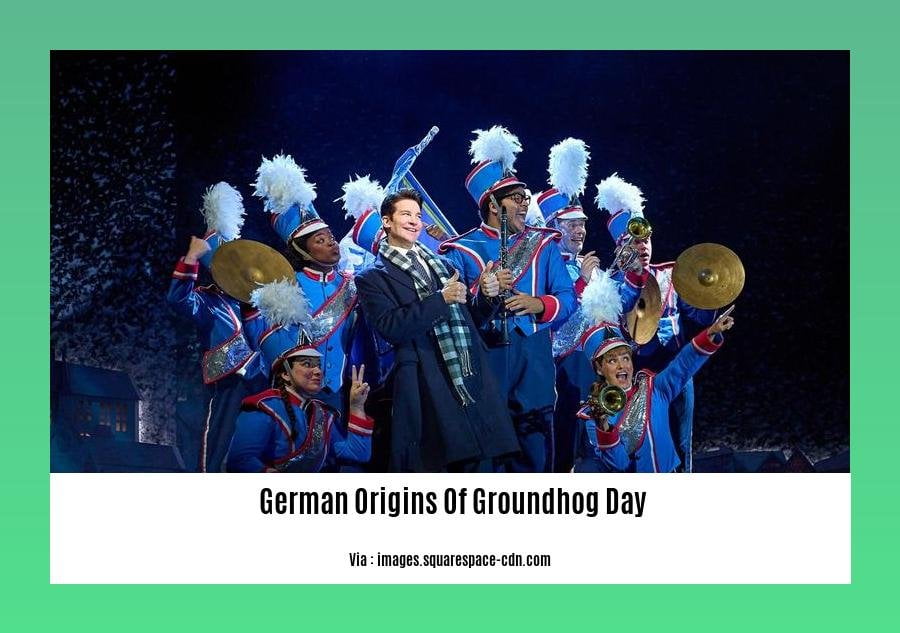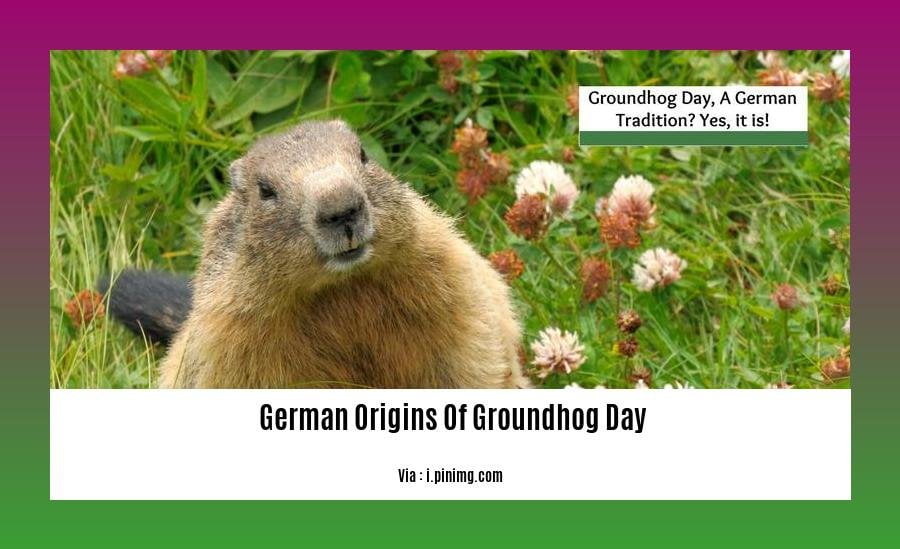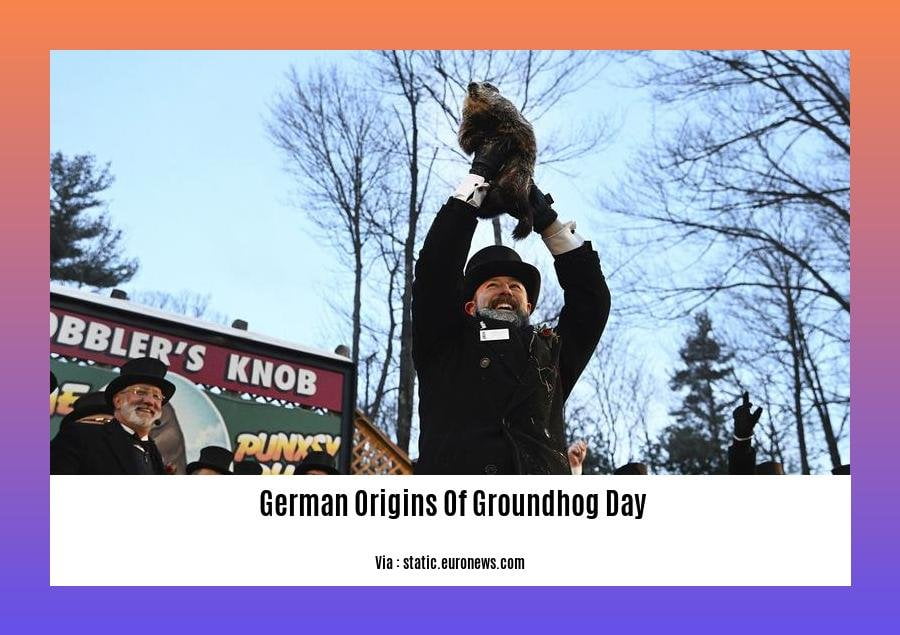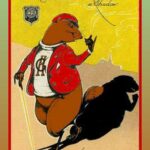– The German Origins of Groundhog Day] – Although today it’s primarily celebrated in the United States and Canada, Groundhog Day finds its roots in ancient Germanic traditions. By exploring the history of this beloved holiday, we will uncover its surprising connections to the rich cultural heritage of Germany.
Key Takeaways:
- Groundhog Day traces back to the Christian tradition of Candlemas.
- Germans adapted the tradition, using hedgehogs to predict weather.
- German immigrants brought the custom to Pennsylvania, replacing hedgehogs with groundhogs.
- Clymer Freas popularized Groundhog Day in Punxsutawney, Pennsylvania.
German Origins of Groundhog Day

The tradition of Groundhog Day, where a furry forecaster predicts the length of winter, has its roots in ancient German origins.
Candlemas: The Christian Precursor
The German origins of Groundhog Day can be traced back to Candlemas, a Christian holiday celebrated on February 2nd. During Candlemas, candles were blessed and their length or brightness was believed to indicate the severity of the remaining winter.
German Expansion: Hedgehogs and Weather
Germans built upon this tradition, using animals, initially hedgehogs, as weather predictors. If the hedgehog cast a shadow on Candlemas, it meant six more weeks of cold weather.
German Immigrants and the Groundhog
When German immigrants settled in Pennsylvania, they brought their Groundhog Day customs with them. However, instead of hedgehogs, they used the native groundhog as their weather-predicting animal.
Punxsutawney Phil: The Popularization of Groundhog Day
The tradition of Groundhog Day was popularized in Punxsutawney, Pennsylvania, by Clymer Freas, the editor of the local newspaper. In 1986, he appointed a groundhog named Punxsutawney Phil as the official weather forecaster.
Conclusion
Groundhog Day, with its origins in ancient Candlemas and German folklore, has become a beloved tradition in the United States. Punxsutawney Phil’s annual prediction continues to capture our imagination and remind us of the enduring connections between our present-day celebrations and the rich tapestry of history.
Discover the fascinating beginnings of Groundhog Day and its enigmatic origins by delving into our comprehensive guide on the History of Groundhog Day.
Unveiling the enigmatic predictions of Punxsutawney Phil, our exclusive article Punxsutawney Phil’s Predictions deciphers the lore behind this legendary groundhog.
Embark on a captivating journey into the time-honored traditions of Groundhog Day by exploring our insightful guide on Groundhog Day Traditions.
Candlemas and Groundhog Day Traditions

Let’s start by understanding the origins of Groundhog Day, which is celebrated on February 2nd.
Imbolc and Candlemas: Celtic and Christian Roots
Groundhog Day finds its origins in the Celtic festival of Imbolc, which marked the beginning of spring. Around the same time, Christians observed Candlemas on February 2nd, a festival associated with light and purification. These two traditions share themes of emerging from winter’s darkness and celebrating new beginnings.
Dachstag: German Influence in America
German immigrants brought their own version of the tradition called “Badger Day” (Dachstag) to America. This tradition used badgers to predict the weather, but in Pennsylvania, groundhogs became the chosen animal.
Similarities and Differences
Both Candlemas and Groundhog Day traditions centered around predicting the severity of winter’s end. However, Candlemas used the length or brightness of candles, while Groundhog Day evolved to observe the behavior of groundhogs.
Key Takeaways:
- Groundhog Day has Celtic and Christian roots, originating from the festivals of Imbolc and Candlemas.
- German immigrants brought their weather-predicting tradition “Dachstag” to America, using groundhogs as their weather-predicting animal.
- Candlemas and Groundhog Day traditions share themes of emerging from winter’s darkness and predicting the arrival of spring.
Citations:
Hedgehog and Badger Traditions
Ever wondered why Groundhog Day is such a big deal in the US? It all started with hedgehog and badger traditions from across the pond. Let’s dig in!
Hedgehogs as Weather Predictors
In Germany, people used to rely on hedgehogs to forecast the weather. On Candlemas (February 2nd), if a hedgehog saw its shadow, it meant six more weeks of winter. Why a hedgehog? Well, they’re known to hibernate during the cold months.
Badgers and German Immigrants
When German immigrants arrived in Pennsylvania, they brought their hedgehog and badger traditions with them. But here’s where it gets interesting: they swapped the European hedgehog for the native groundhog. And that’s how Groundhog Day was born!
Punxsutawney Phil
Today, Punxsutawney Phil is the most famous groundhog weather predictor. Every February 2nd, a crowd gathers to witness Phil’s shadow dance. If he sees it, we’re in for a long, cold winter.
Key Takeaways:
- Hedgehogs and badgers were used as weather predictors in Europe
- German immigrants brought these traditions to the US
- The groundhog replaced the hedgehog as the official weather forecaster
- Punxsutawney Phil is the most well-known groundhog predictor
Sources:
The modern American tradition of Groundhog Day
Everybody knows that the modern American tradition of Groundhog Day involves a furry little creature named Punxsutawney Phil and making weather predictions, but have you ever thought about the origins of this quirky holiday? Turns out, it’s a tale that spans centuries and continents.
As the legend goes, the modern American tradition of Groundhog Day can be traced back to a Christian festival called Candlemas, celebrated on February 2nd. During Candlemas, people would look for signs of spring. If the sun was shining and they could see their shadow, it meant that winter would last another six weeks.
Over time, this tradition made its way to Germany, where people started using hedgehogs to make weather predictions. German immigrants brought this custom with them when they settled in Pennsylvania, and soon enough, the groundhog became the animal of choice for predicting the arrival of spring.
The most famous groundhog, Punxsutawney Phil, has been making weather predictions since 1887. Phil’s predictions are taken very seriously, and he has even been known to influence the stock market.
The modern American tradition of Groundhog Day is an enduring one, and this lighthearted and charming practice continues to captivate people year after year.
Key Takeaways:
- The modern American tradition of Groundhog Day originated from Candlemas, a Christian festival.
- German immigrants brought the tradition of using animals to predict the weather to Pennsylvania.
- The groundhog became the animal of choice for weather predictions in Pennsylvania.
- Punxsutawney Phil is the most famous groundhog weather predictor.
- The modern American tradition of Groundhog Day is a beloved tradition that continues to this day.
Sources:
FAQ
Q1: Where did the tradition of using an animal to predict the weather originate?
A1: The tradition originated in Christian festivals, using an animal similar to a groundhog to forecast the length and severity of winter.
Q2: How did the groundhog become associated with weather prediction?
A2: German immigrants in Pennsylvania adopted the Christian tradition and used the groundhog, native to the region, as their weather-predicting animal.
Q3: What is the connection between Groundhog Day and Candlemas?
A3: Groundhog Day is believed to have originated from the Christian festival of Candlemas, where candles were used to symbolize the length and severity of winter, and animals were used for weather prediction.
Q4: Who popularized the Groundhog Day tradition in Punxsutawney, Pennsylvania?
A4: Clymer Freas, the editor of the local Punxsutawney Spirit newspaper, popularized the Groundhog Day tradition in Punxsutawney.
Q5: What is the significance of Punxsutawney Phil?
A5: Punxsutawney Phil is the most famous groundhog prognosticator and is maintained by the Pennsylvania’s Groundhog Club, which keeps statistics on his weather predictions.




![[Facts about Germany culture]: Unveiling the Rich Tapestry of German Traditions and Heritage Facts-about-Germany-culture_2](https://www.lolaapp.com/wp-content/uploads/2023/12/Facts-about-Germany-culture_2-150x150.jpg)




